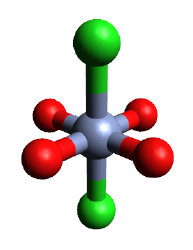 | |
 | |
| Names | |
|---|---|
| IUPAC name Chromium(II) chloride | |
| Other names Chromous chloride | |
| Identifiers | |
| |
3D model (JSmol) |
|
| ChemSpider | |
| ECHA InfoCard | 100.030.136 |
| EC Number |
|
PubChem CID | |
| RTECS number |
|
| UNII |
|
| UN number | 3077 |
CompTox Dashboard (EPA) | |
| |
| |
| Properties | |
| Cl2Cr | |
| Molar mass | 122.90 g·mol−1 |
| Appearance | White to grey/green powder (anhydrous) blue solid (tetrahydrate) |
| Odor | Odorless |
| Density | 2.88 g/cm3 (24 °C) [1] |
| Melting point | 824 °C (1,515 °F; 1,097 K) anhydrous 51 °C (124 °F; 324 K) tetrahydrate, decomposes [1] |
| Boiling point | 1,302 °C (2,376 °F; 1,575 K) anhydrous [1] |
| Soluble [1] | |
| Solubility | Insoluble in alcohol, ether |
| Acidity (pKa) | 2 |
| +7230·10−6 cm3/mol | |
| Structure | |
| Orthorhombic (deformed rutile, anhydrous), oP6 [2] Monoclinic (tetrahydrate) [3] | |
| Pnnm, No. 58 (anhydrous) [2] P21/c, No. 14 (tetrahydrate) [3] | |
| 2/m 2/m 2/m (anhydrous) [2] 2/m (tetrahydrate) [3] | |
α = 90°, β = 90°, γ = 90° | |
| Octahedral (Cr2+, anhydrous) [2] | |
| Thermochemistry | |
Heat capacity (C) | 71.2 J/mol·K [1] |
Std molar entropy (S⦵298) | 115.3 J/mol·K [1] |
Std enthalpy of formation (ΔfH⦵298) | −395.4 kJ/mol [1] |
Gibbs free energy (ΔfG⦵) | −356 kJ/mol [1] |
| Hazards | |
| GHS labelling: | |
 [4] [4] | |
| Warning | |
| H302, H315, H319, H335 [4] | |
| P261, P305+P351+P338 [4] | |
| NFPA 704 (fire diamond) | |
| Lethal dose or concentration (LD, LC): | |
LD50 (median dose) | 1870 mg/kg (rats, oral) [5] |
| Safety data sheet (SDS) | Oxford MSDS |
| Related compounds | |
Other anions | Chromium(II) fluoride Chromium(II) bromide Chromium(II) iodide |
Other cations | Chromium(III) chloride Chromium(IV) chloride Molybdenum(II) chloride Tungsten(II) chloride |
Except where otherwise noted, data are given for materials in their standard state (at 25 °C [77 °F], 100 kPa). | |
Chromium(II) chloride describes inorganic compounds with the formula Cr Cl 2(H2O)n. The anhydrous solid is white when pure, however commercial samples are often grey or green; it is hygroscopic and readily dissolves in water to give bright blue air-sensitive solutions of the tetrahydrate Cr(H2O)4Cl2. Chromium(II) chloride has no commercial uses but is used on a laboratory-scale for the synthesis of other chromium complexes.

